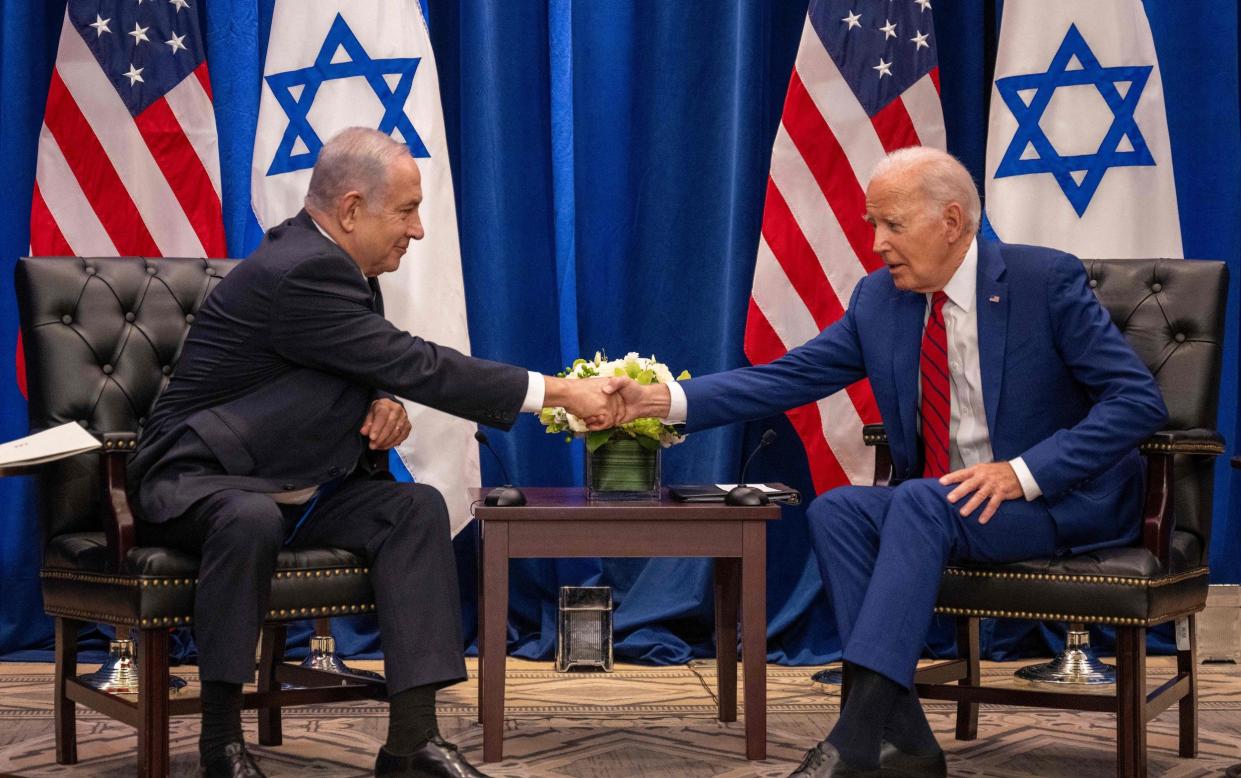America can’t grab the wheel from Netanyahu in Gaza

- Oops!Something went wrong.Please try again later.
Depending on which Israeli official you ask, Israel is either close to a total and complete win over Hamas in Gaza or in the middle of what will be a long, grinding year ahead. On April 7, Israeli Prime Minister Benjamin Netanyahu told his cabinet that “we are one step away from victory” after nearly eight long months of combat. Yet Tzachi Hanegbi, Netanyahu’s national security adviser, had an altogether different assessment of the situation this week: “We’re now in the fifth month of 2024, which means that this year we are expecting another seven months of fighting.”
Whoever you believe, one thing is indisputable: Israel doesn’t have a plan in Gaza. Netanyahu, the longest-serving prime minister in Israel’s history, is winging it.
At first glance, this would seem like an odd statement to make. Israel, after all, has consistently stated that it has two objectives for this military campaign: defeating Hamas and freeing the remaining hostages.
Yet those two objectives have proven to be irreconcilable. While Netanyahu argues that military pressure is crucial to getting the rest of the hostages released, the facts thus far have demonstrated otherwise. To Hamas, the hostages are bargaining chips meant to force Israel to end the war permanently and for good – something Netanyahu has ruled out.
Under its most extensive military pressure since the movement was founded more than thirty-five years ago, Hamas simply has no reason to hand over the hostages for anything short of an immediate, comprehensive and internationally-guaranteed ceasefire. Unless Netanyahu agrees to this, it’s hard to see a deal being struck.
As difficult as this issue is, the long-term challenge is even more daunting. To put it bluntly, Israel’s plans for how to manage Gaza after the war range between delusional to nonexistent.
Netanyahu’s first crack at a post-war proposal was a vision of what he would like to see rather than what is realistically possible. In that plan, Israel would maintain indefinite security control over Gaza while handing over the labourious work of civil affairs to Israeli-approved Palestinians with no links to Hamas or the Palestinian Authority (PA).
Yet this plan was basically laughed out of the room. No Palestinian will risk his or her life and reputation cooperating with an Israeli-authored scheme. Arab states like Saudi Arabia, Qatar and Egypt, who will be counted on to finance reconstruction, won’t participate in a plan that makes it easier for Israel to maintain a de-facto occupation over Gaza’s 2.4 million Palestinians.
The obvious question then arises: what next? Unfortunately for Israel, its choices are limited.
The first option could best be described as “declare victory and go home.” After destroying the last four Hamas battalions in the city of Rafah, Israeli troops could withdraw from Gaza entirely, ensure its border with Gaza was secure and continue the “mowing the grass” strategy it has executed for the previous decade and a half. When threats from Hamas or other Palestinian militant groups in Gaza re-surface, Israel could take military action to neutralise them.
But in the grand scheme this is a conflict management strategy, not a long-term solution. None of the issues that have turned the Israeli-Palestinian dispute into one of the world’s longest will get addressed, let alone resolved. Israeli-Palestinian peace negotiations would likely remain off the docket; Hamas would use an Israeli pullout to regenerate; and Israel would again find itself in a situation where military action is likely, if not imminent.
The second option is an Israeli military occupation of Gaza to keep Hamas as degraded as possible. Yet nobody but the most extreme members of Netanyahu’s ultranationalist cabinet would support this. On May 15, Defense Minister Yoav Gallant ruled it out as long as he led the defense ministry. The Israeli military leadership wouldn’t endorse it either, since an occupation would entail fighting a long-term insurgency as well as caring for the basic needs of more than two million people there. And the Biden administration wouldn’t endorse it; even before Israeli troops began ground operations, President Biden was on record telling Israel that re-occupying Gaza “would be a mistake.”
The third option would be bringing the PA back into Gaza to administer the territory. This isn’t a panacea. The PA is a notoriously corrupt institution and deeply unpopular in the eyes of the Palestinian public, which has long viewed it as a sub-contractor for Israel. PA President Mahmoud Abbas is as old as he is deplored, with only 14 per cent of Palestinians satisfied with him. There is also a legitimate question as to whether the PA has the capacity to administer Gaza given its sub-par record in the West Bank.
Even so, the last option is the best – or least bad – on the list. The PA at least possesses some experience in the basics of governing, and it’s really the only Palestinian alternative to Hamas today. Allowing the PA to control Gaza would give Israel the opportunity to disassociate itself from the enclave and is far more likely to bring Arab states onside in the process. Unfortunately, Netanyahu would rather see the PA wither than strengthen, which could increase US pressure on Israel to eventually resume negotiations on a Palestinian state.
Regardless of what Netanyahu decides to do, the United States needs to stay out of the Gaza maelstrom. While Washington is likely to have a role post-conflict, under no circumstances should the US military be deployed in Gaza to keep the peace or maintain order – either alone or as part of a multinational peacekeeping mission. Israel and the rest of the region’s stakeholders need to take the lead here. The best the US can do is advise Israel not to make any more bad decisions.

